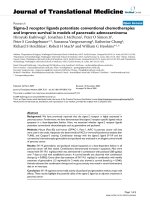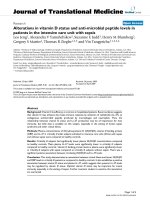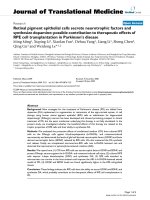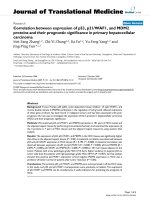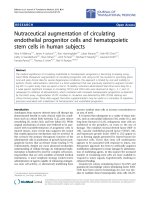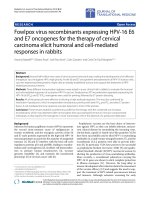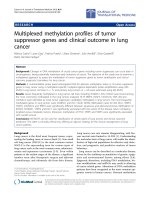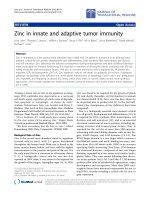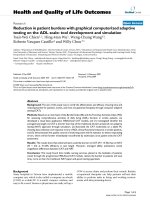Báo cáo hóa học: " Alterations in intracellular potassium concentration by HIV-1 and SIV Nef" pptx
Bạn đang xem bản rút gọn của tài liệu. Xem và tải ngay bản đầy đủ của tài liệu tại đây (542.72 KB, 6 trang )
BioMed Central
Page 1 of 6
(page number not for citation purposes)
Virology Journal
Open Access
Research
Alterations in intracellular potassium concentration by HIV-1 and
SIV Nef
Bongkun Choi*
1,3
, Cesar D Fermin
2
, Alla M Comardelle
1
,
Allyson M Haislip
1
, Thomas G Voss
1
and Robert F Garry
1
Address:
1
Department of Microbiology and Immunology, Tulane University Health Sciences Center, New Orleans, LA 70112, USA,
2
College of
Veterinary Medicine, Nursing & Allied Health (CVMNAH), Tuskegee University, Tuskegee, AL 36088, USA and
3
Departments of Environmental
Medicine, Pathology, and Medicine, New York University School of Medicine, Tuxedo, NY 10987, USA
Email: Bongkun Choi* - ; Cesar D Fermin - ; Alla M Comardelle - ;
Allyson M Haislip - ; Thomas G Voss - ; Robert F Garry -
* Corresponding author
Abstract
Background: HIV-1 mediated perturbation of the plasma membrane can produce an alteration in
the transmembrane gradients of cations and other small molecules leading to cell death. Several
HIV-1 proteins have been shown to perturb membrane permeability and ion transport. Xenopus
laevis oocytes have few functional endogenous ion channels, and have proven useful as a system to
examine direct effects of exogenously added proteins on ion transport.
Results: HIV-1 Nef induces alterations in the intracellular potassium concentration in CD4+ T-
lymphoblastoid cells, but not intracellular pH. Two electrode voltage-clamp recording was used to
determine that Nef did not form ion channel-like pores in Xenopus oocytes.
Conclusion: These results suggest that HIV-1 Nef regulates intracellular ion concentrations
indirectly, and may interact with membrane proteins such as ion channels to modify their electrical
properties.
Introduction
During primary infection by HIV-1 or simian immunode-
ficiency virus (SIV) there is a rapid and nearly complete
depletion of the mucosal CD4+ T cell population [1]. This
initial phase is followed by a prolonged phase in which
there is a gradual decline in the overall numbers of periph-
eral CD4+ T cells, which appears to reflect accelerated
rates of cell death and replacement [2]. Direct HIV-1
mediated cell killing appears to be a major factor in both
phases of CD4+ T-lymphocyte loss in AIDS or simian
AIDS (SAIDS), although immune dysregulation and other
factors also contribute [3,4]. Homostatic mechanisms
attempting to replenish the CD4+ T cell pool eventually
fail, leading to collapse of the naïve T cell regenerative
potential and ultimately to immune system collapse [5].
Direct cytopathic effects mediated by HIV-1 or virion
components may also be involved in other aspects of len-
tivirus pathogenesis, such as the induction of neurological
dysfunctions [4,6,7]. HIV-1 mediated perturbation of the
cellular membranes can produce an alteration in the
transmembrane gradients of cations and other small mol-
ecules leading to cell death by lysis, cell-cell fusion, apop-
tosis and necrosis [8-10]. Acute cytopathic infection by
HIV-1 increases the intracellular concentrations of
sodium and potassium, but decreases intracellular pH
[3,11,12]. Several HIV-1 proteins alter cellular electro-
Published: 19 May 2008
Virology Journal 2008, 5:60 doi:10.1186/1743-422X-5-60
Received: 5 May 2008
Accepted: 19 May 2008
This article is available from: />© 2008 Choi et al; licensee BioMed Central Ltd.
This is an Open Access article distributed under the terms of the Creative Commons Attribution License ( />),
which permits unrestricted use, distribution, and reproduction in any medium, provided the original work is properly cited.
Virology Journal 2008, 5:60 />Page 2 of 6
(page number not for citation purposes)
physiological properties. Vpr causes a large inward current
and cell death in cultured hippocampal neurons [13]. Vpu
forms cationic channels [14] and induces a K+ conduct-
ance in Xenopus oocytes [15], while Tat blocks L-type
Ca2+ channels in dendritic cells [16]. The surface glyco-
protein (SU) of HIV-1 activates the Na+/H+ antiport and
K+ conductance in astrocytes [17]. The lentivirus lytic pep-
tide domains of the HIV and SIV transmembrane glyco-
protein (TM) also alter the permeability of cell
membranes [18,19].
HIV-1 Nef is encoded by an open reading frame located at
the 3' end of the viral genome, partially overlapping the 3'
long terminal repeat (LTR) and conserved in all strains of
HIV-1, HIV-2, and SIV. This protein is synthesized in every
stage of the viral replication cycle, and is associated with
cellular membranes via an N-terminal myristic acid
[20,21]. Nef is an important regulator in the development
of AIDS pathology. It down-regulates both the surface
expression of CD4, the primary receptor for HIV-1 in T
lymphocytes and macrophages [22], and MHC class I
molecules [23]. Nef also enhances viral infectivity during
the process of virion assembly and upregulates viral repli-
cation both in cell culture and in animal systems [20,24].
Nef inhibits a large-conductance potassium channel in
human glial cells [7]. This study was undertaken to further
investigate the possible role of Nef protein in HIV-medi-
ated membrane modification using recombinant HIV-1
and SIV Nef proteins and Xenopus oocytes, a well-charac-
terized system to evaluate effects of exogenously added
proteins on ion transport.
Results
Alteration of intracellular potassium concentrations by
recombinant Nef
To quantify the effect of Nef on intracellular potassium
concentrations ([K+]), RH9 cells from a CD4+ T-lym-
phoblastoid cell line were loaded with an ion-sensitive
fluorescent dye, potassium-binding benzofuran isophtha-
late-acetoxymethyl ester (PBFI-AM) and then incubated
with various concentrations of recombinant HIV-1 Nef for
15 min at 37°C. K+ fluorescence intensity was monitored
using a fluorescence concentration analyzer. Incubation
with HIV-1 Nef resulted in a decrease of intracellular
potassium concentration in a dose dependent manner
(Fig. 1A). RH9 cells incubated with recombinant SIV Nef
also reduced intracellular [K+] (not shown). In contrast,
H9 cells incubated with Nef maintained intracellular pH
at a similar level to that of mock-infected H9 cells
throughout various concentrations of Nef in the medium
(Fig 1B).
The change in intracellular K+ concentration is not due to
a nonspecific quenching of fluorescence as a consequence
of incubation with Nef. Examination of representative
light (Fig. 2A and 2B) and fluorescence microscopic (Fig
2C and 2D) images confirmed the results using fluores-
cence concentration analysis of cell populations. Relative
to mock-infected RH9 cells (Fig. 2C), RH9 cells incubated
with Nef showed a decrease in PBFI fluorescence emission
(yellow: a higher [K+], red: lower ([K+]), indicating a
decrease in intracellular K+ concentration.
Recombinant Nef does not alter transmembrane currents
of Xenopus laevis oocytes
To investigate the interaction of Nef with the plasma
membrane, recombinant Nef was incubated with Xenopus
laevis oocytes, and two electrode voltage-clamp recording
was performed. A useful property of Xenopus oocytes is
Alterations in intracellular K+ in T-lymphoblastoid cells incu-bated with recombinant HIV-1 and SIV Nef proteinFigure 1
Alterations in intracellular K+ in T-lymphoblastoid
cells incubated with recombinant HIV-1 and SIV Nef
protein. H9 cells were loaded either with the K+ sensitive
fluorescent indicated PBFI-AM (panel A) or the pH sensitive
fluorescent indicator BCECF-AM (Panel B), then incubated
with various concentrations of recombinant HIV-1 or SIV
Nef protein for 15 min at 37°C, and fluorescence intensity
was measured by using a fluorescence concentration ana-
lyzer. Each data point represents the mean ± standard error
of eight independent determinations.
0
5000
10000
15000
20000
0 50 100 150 200 250 300
Nef (nM)
Flourescence intensity of PBFI
0
10000
20000
30000
40000
50000
60000
0 50 100 150 200 250 300
Nef (nM)
Flourescence intensity of BCECF
Virology Journal 2008, 5:60 />Page 3 of 6
(page number not for citation purposes)
that these cells have few endogenous membrane ion chan-
nels to interfere with measurement of potential pore-
forming proteins [25]. HIV-1 Lentivirus lytic peptide
(LLP-1) or the bee venom peptide melittin that are known
to form ion channel-like pores in membranes induced
increase in transmembrane currents of Xenopus oocytes.
Nef failed to induce a current differing from that of
untreated oocytes within 30 sec even at 300 nM, a concen-
tration shown to be cytostatic (Fig. 3). No increase in
transmembrane currents was observed in measurements
at 5 or 30 min after addition of 300 nM of Nef, unlike LLP-
1 or bee venom peptide melittin [25]. These results sug-
gest that Nef does not form an ion-channel-like structure,
but rather may interact with ion channels to affect K+ lev-
els in other cells, such as CD4+ lymphocytes.
Discussion
The results presented here add to previous studies suggest-
ing that alteration of membrane ion transport and perme-
ability are important mechanisms for HIV-1
cytopathogenesis. The intracellular K+ concentration is
reduced in T-lymphoblastoid cells in the presence of exog-
enously added Nef. This alteration is selective, since intra-
cellular pH was unaffected. Potassium channels are
among the primary machinery mediating ion homeosta-
sis in human lymphocytes. Therefore, modulation of
intracellular K+ concentration by Nef may be involved in
HIV-1 mediated cytopathogenesis. Previously, soluble
Nef was shown to be cytostatic and cytotoxic against both
CD4+ T cells and monocytoid cell lines [25].
Several viral proteins, including influenza A virus M2,
influenza B virus NB, HIV-1 Env, Vpu, and Vpr, induce
alterations in cellular membrane permeability or ion
Fluorescent and light microscopic analysis of alteration in intracellular K+ concentrations in H9 cells treated with recombinant NefFigure 2
Fluorescent and light microscopic analysis of altera-
tion in intracellular K+ concentrations in H9 cells
treated with recombinant Nef. H9 cells were loaded
with the fluorescent indicator PBFI-AM and incubated with
300 nM recombinant Nef protein or with control medium
without Nef for 15 min at 37°C. Control cells (A and C) and
cells incubated with Nef protein (B and D) were examined by
light (A and B) and fluorescent (C and D) microscopy.
A
B
C
D
10 µm
Membrane currents in Xenopus oocytes exposed to Nef pro-teinFigure 3
Membrane currents in Xenopus oocytes exposed to
Nef protein. (A) 300 nM recombinant Nef, (B) control
oocyte Panel C: current:voltage plots determined from data
recorded in panel A and B.
A
B
C
300 nM Nef
control
control
300 nM Nef
400 nA
40 ms
-80
80
-20 nV
Virology Journal 2008, 5:60 />Page 4 of 6
(page number not for citation purposes)
transport [26]. The classic example of a virally-encoded
ion channel (viroporin) is the M2 protein of influenza
virus, which forms a well-characterized proton channel
and is also a target for an important class of anti-influenza
drugs [27]. HIV-1 Vpu structurally resembles M2 and
forms a pH-independent ion channel in lipid bilayers
[28]. Vpr also appears to have ion channel like properties
[13]. The LLP domains of HIV TM also have the capacity
to interact with membranes and alter permeability
[18,29]. In contrast to these other HIV-1 proteins, Nef
does not appear to directly modify permeability or form
an ion-channel-like structure. Rather, Nef may interact
with ion channels and modify their electrical properties.
Previous studies by Kort and others are consistent with
this hypothesis. Nef has been demonstrated to inhibit a
large-conductance potassium channel in human glial cells
and to inhibit the activity of a Ca2+ -dependent K+ chan-
nel in a T lymphocyte cell line [7]. The structural similarity
of Nef to snake neurotoxins is additional evidence for the
role of Nef in ion channel modulation, and is suggestive
of a role of Nef in AIDS-associated neuropathologies [30].
Snake neurotoxins are known to interact with ion chan-
nels. Direct effects of Nef on cell membranes are not
excluded by our studies. Indeed, Nef has also been shown
to cause perturbation and fusion of artificial membranes
and lysis of human lymphocytes and red blood cells [31].
It has been observed that exogenous Nef causes cell death
in yeast and bacterial cell due to permeabilization of the
cell membranes [32].
This effect of Nef proteins shown in this study requires the
presence of the protein extracellularly. This could be
achieved by lysis of HIV-infected cells in patients. Anti-
bodies against Nef have been detected in HIV-infected
individuals [33], suggesting the extracellular presence of
Nef in vivo. The concentrations of Nef used in the current
experiments are likely to be physiologically relevant. A
high percentage of sera samples from HIV-1 positive indi-
viduals contained Nef at a concentration 5–10 ng/ml
(approximately 0.2–0.4 nM) that was shown to be cyto-
static [33]. This implies that effective Nef concentrations
achieved locally in tissues where HIV-1 replicates, such as
intestine, lymph node, and brain, prior to dilution in the
vasculature might be several orders of magnitude higher
consistent with concentrations (mid nM) shown here to
affect [K+] in lymphoid cells.
The overall affect of HIV-1 infection on K+ transport is
likely to be complex. Our previous studies indicated that
during cytopathic infection intracellular [K+] increases
[12,34]. Furthermore, increased intracellular [K+] in
infected cells enhances HIV-1 replication and accelerates
cell killing, particularly the CPE described as "ballooning
degeneration" [34]. Therefore, it is possible that Nef may
function in a regulatory or compensatory role for ion
fluxes mediated by other HIV-1 proteins.
Materials and methods
Cells, virus and recombinant proteins
Cells of the RH9 subclone of the CD4+ human T-lym-
phoblastoid cell line RH9 were the kind gift of Dr. Suraiya
Rasheed (University of Southern California), and were
maintained in RPMI 1640 supplemented with 10% fetal
bovine serum[6] (GIBCO, Long Island, NY), penicillin
(100 U/ml) and streptomycin (100 µg/ml). Oocytes were
removed from anesthetized Xenopus laevis, and prepared
for electrophysiological evaluation as previously
described [18]. All animal experiments were evaluated
and approved by the Tulane University Health Sciences
Center Institutional Animal Care and Use Committee.
Recombinant HIV-1 and SIV Nef was obtained from the
NIH AIDS Research & Reference Reagent Program.
Measurement of intracellular potassium and pH
concentrations with fluorescent indicators
Potassium-binding benzofuran isophthalate-acetoxyme-
thyl ester (PBFI-AM) was used for fluorometric determina-
tion of ion ceoncentrations in intact, living cells [12].
Intracellular pH in RH9 cells were measured using the pH-
sensitive fluorescence dye 2'7'-bis(2-carboxyethyl)-5(6)-
carboxyfluorescein-acetoxymethyl ester (BCECF-AM)
[11]. The acetoxymethyl ester group linked to each dye
renders the molecule uncharged and thereby able to per-
meate living cell membranes. Once inside the cell, the
lipophilic blocking groups are cleaved by endogenous cel-
lular esterases, resulting in a charge free acid that is unable
to pass through the cell membrane. Upon binding by tar-
get ion, the excitation maximum of this fluorescent indi-
cator shifts to shorter wavelengths, causing a large
alteration in the ratio of energy absorbed. This induces a
2.5 fold enhancement of fluorescent intensity with little
change in the emission maximum. After adding PBFI- AM
or BCECF-AM at final concentration of 10 µM or µM, cells
were incubated for 2 hours or 30 min, respectively. Cells
labeled with PBFI or BCECF were plated into 96-well
Fluoricon GF assay plate (10,000 cells per well) fitted with
a glass fiber filter (1.0 µm pore size), and washed three
times. The FCA allows vacuuming of solutions through
the well thereby concentrating cells at the bottom. To pre-
vent cells from clogging the filter membrane, inert poly-
styrene particles (3.3 µm diameter) were added to each
well prior to addition of cells. PBFI and BCECF fluores-
cence intensity were determined with the photomultiplier
gain set at 100. 8 replicates were quantified for each sam-
ple. Microscopic analysis of cells loaded with fluorescent
indicator of K+ was performed as previously described
[11,12].
Virology Journal 2008, 5:60 />Page 5 of 6
(page number not for citation purposes)
Two-electrode voltage clamping
The whole-cell currents were measured with a GeneClamp
500 amplifier using two microelectrodes as previously
described [25]. Currents in oocytes exposed to 300 nM
recombinant Nef were determined by holding the mem-
brane voltage to a set point of -20 mV, then changing the
membrane voltage stepwise from -80 to +80 mV in 20 mV
increments by 280- msec pulses with 60-msec prepulse at
-80 mV and a 60 msec afterplus at -80 mV. Measurements
were conducted within 30 sec of adding Nef to the circu-
lating bath.
Conclusion
HIV-1 Nef induce alterations in the intracellular [K+] in
CD4+ T-lymphoblastoid cells, but not intracellular pH.
Nef proteins do not form ion channel-like pores in Xeno-
pus oocytes and may regulate intracellular [K+] in CD4+
lymphocytes, and perhaps other cell types, by interacting
with monovalent ion channels.
Competing interests
The authors declare that they have no competing interests.
Authors' contributions
BC performed all experiments with substantial help from
AMC. RFG, TGV and CDF provided guidance, expertise,
equipment, and funding for these experiments. All
authors have read and approved this manuscript.
Acknowledgements
This research was supported by Public Health Service grants AI054238,
AI054626 and AI068230 from the National Institute of Allergy and Infec-
tious Diseases.
References
1. Veazey RS, DeMaria M, Chalifoux LV, Shvetz DE, Pauley DR, Knight
HL, Rosenzweig M, Johnson RP, Desrosiers RC, Lackner AA: Gas-
trointestinal tract as a major site of CD4+ T cell depletion
and viral replication in SIV infection. Science 1998,
280(5362):427-431.
2. Cooper DA, Gold J, Maclean P, Donovan B, Finlayson R, Barnes TG,
Michelmore HM, Brooke P, Penny R: Acute AIDS retrovirus
infection. Definition of a clinical illness associated with sero-
conversion. Lancet 1985, 1(8428):537-540.
3. Garry RF, Gottlieb AA, Zuckerman KP, Pace JR, Frank TW, Bostick
DA: Cell surface effects of human immunodeficiency virus.
Biosci Rep 1988, 8(1):35-48.
4. Costin JM: Cytopathic mechanisms of HIV-1. Virol J 2007, 4:100.
5. Nishimura Y, Igarashi T, Buckler-White A, Buckler C, Imamichi H,
Goeken RM, Lee WR, Lafont BA, Byrum R, Lane HC: Loss of naive
cells accompanies memory CD4+ T-cell depletion during
long-term progression to AIDS in Simian immunodeficiency
virus-infected macaques. J Virol 2007, 81(2):893-902.
6. Garry RF: Potential mechanisms for the cytopathic properties
of HIV. Aids 1989, 3(11):683-694.
7. Kort JJ, Jalonen TO: The nef protein of the human immunode-
ficiency virus type 1 (HIV-1) inhibits a large-conductance
potassium channel in human glial cells. Neurosci Lett 1998,
251(1):1-4.
8. Rasheed S, Gottlieb AA, Garry RF: Cell killing by ultraviolet-inac-
tivated human immunodeficiency virus. Virology 1986,
154(2):395-400.
9. Fermin CD, Garry RF: Membrane alterations linked to early
interactions of HIV with the cell surface. Virology 1992,
191(2):941-946.
10. Gatti PJ, Choi B, Haislip AM, Fermin CD, Garry RF: Inhibition of
HIV type 1 production by hygromycin B. AIDS Res Hum Retro-
viruses 1998, 14(10):885-892.
11. Makutonina A, Voss TG, Plymale DR, Fermin CD, Norris CH, Vigh S,
Garry RF: Human immunodeficiency virus infection of T-lym-
phoblastoid cells reduces intracellular pH. J Virol 1996,
70(10):7049-7055.
12. Voss TG, Fermin CD, Levy JA, Vigh S, Choi B, Garry RF: Alteration
of intracellular potassium and sodium concentrations corre-
lates with induction of cytopathic effects by human immun-
odeficiency virus. J Virol 1996, 70(8):5447-5454.
13. Piller SC, Ewart GD, Premkumar A, Cox GB, Gage PW: Vpr protein
of human immunodeficiency virus type 1 forms cation-selec-
tive channels in planar lipid bilayers. Proc Natl Acad Sci U S A
1996, 93(1):111-115.
14. Schubert U, Ferrer-Montiel AV, Oblatt-Montal M, Henklein P, Strebel
K, Montal M: Identification of an ion channel activity of the
Vpu transmembrane domain and its involvement in the reg-
ulation of virus release from HIV-1-infected cells. FEBS Lett
1996, 398(1):12-18.
15. Coady MJ, Daniel NG, Tiganos E, Allain B, Friborg J, Lapointe JY,
Cohen EA: Effects of Vpu expression on Xenopus oocyte
membrane conductance. Virology 1998, 244(1):39-49.
16. Poggi A, Rubartelli A, Zocchi MR: Involvement of dihydropyrid-
ine-sensitive calcium channels in human dendritic cell func-
tion. Competition by HIV-1 Tat. J Biol Chem 1998,
273(13):7205-7209.
17. Bubien JK, Benveniste EN, Benos DJ: HIV-gp120 activates large-
conductance apamin-sensitive potassium channels in rat
astrocytes. Am J Physiol 1995, 268(6 Pt 1):C1440-9.
18. Comardelle AM, Norris CH, Plymale DR, Gatti PJ, Choi B, Fermin
CD, Haislip AM, Tencza SB, Mietzner TA, Montelaro RC, Garry RF:
A synthetic peptide corresponding to the carboxy terminus
of human immunodeficiency virus type 1 transmembrane
glycoprotein induces alterations in the ionic permeability of
Xenopus laevis oocytes. AIDS Res Hum Retroviruses 1997,
13(17):1525-1532.
19. Costin JM, Rausch JM, Garry RF, Wimley WC: Viroporin potential
of the lentivirus lytic peptide (LLP) domains of the HIV-1
gp41 protein. Virol J 2007, 4:123.
20. Kestler HW 3rd, Ringler DJ, Mori K, Panicali DL, Sehgal PK, Daniel
MD, Desrosiers RC: Importance of the nef gene for mainte-
nance of high virus loads and for development of AIDS. Cell
1991, 65(4):651-662.
21. Fackler OT, Kienzle N, Kremmer E, Boese A, Schramm B, Klimkait T,
Kucherer C, Mueller-Lantzsch N: Association of human immun-
odeficiency virus Nef protein with actin is myristoylation
dependent and influences its subcellular localization. Eur J Bio-
chem 1997, 247(3):843-851.
22. Garcia JV, Miller AD: Serine phosphorylation-independent
downregulation of cell-surface CD4 by nef. Nature 1991,
350(6318):508-511.
23. Schwartz O, Marechal V, Le Gall S, Lemonnier F, Heard JM: Endocy-
tosis of major histocompatibility complex class I molecules
is induced by the HIV-1 Nef protein. Nat Med 1996,
2(3):338-342.
24. Jamieson BD, Aldrovandi GM, Planelles V, Jowett JB, Gao L, Bloch LM,
Chen IS, Zack JA: Requirement of human immunodeficiency
virus type 1 nef for in vivo replication and pathogenicity. J
Virol 1994, 68(6):3478-3485.
25. Cooke SJ, Coates K, Barton CH, Biggs TE, Barrett SJ, Cochrane A,
Oliver K, McKeating JA, Harris MP, Mann DA: Regulated expres-
sion vectors demonstrate cell-type-specific sensitivity to
human immunodeficiency virus type 1 Nef-induced cytosta-
sis. J Gen Virol 1997, 78 ( Pt 2):381-392.
26. Carrasco L: Modification of membrane permeability by ani-
mal viruses. Adv Virus Res 1995, 45:61-112.
27. Lamb RA, Pinto LH: Do Vpu and Vpr of human immunodefi-
ciency virus type 1 and NB of influenza B virus have ion chan-
nel activities in the viral life cycles? Virology 1997, 229(1):1-11.
28. Ewart GD, Sutherland T, Gage PW, Cox GB: The Vpu protein of
human immunodeficiency virus type 1 forms cation-selec-
tive ion channels. J Virol 1996, 70(10):7108-7115.
Publish with BioMed Central and every
scientist can read your work free of charge
"BioMed Central will be the most significant development for
disseminating the results of biomedical research in our lifetime."
Sir Paul Nurse, Cancer Research UK
Your research papers will be:
available free of charge to the entire biomedical community
peer reviewed and published immediately upon acceptance
cited in PubMed and archived on PubMed Central
yours — you keep the copyright
Submit your manuscript here:
/>BioMedcentral
Virology Journal 2008, 5:60 />Page 6 of 6
(page number not for citation purposes)
29. Plymale DR, Comardelle AM, Fermi CD, Martin DS, Costin JM, Nor-
ris CH, Tencza SB, Mietzner TA, Montelaro RC, Garry RF: Concen-
tration-dependent differential induction of necrosis or
apoptosis by HIV-1 lytic peptide 1. Peptides 1999,
20(11):1275-1283.
30. Werner T, Ferroni S, Saermark T, Brack-Werner R, Banati RB, Mager
R, Steinaa L, Kreutzberg GW, Erfle V: HIV-1 Nef protein exhibits
structural and functional similarity to scorpion peptides
interacting with K+ channels. Aids 1991, 5(11):1301-1308.
31. Curtain CC, Lowe MG, Arunagiri CK, Mobley PW, Macreadie IG,
Azad AA: Cytotoxic activity of the amino-terminal region of
HIV type 1 Nef protein. AIDS Res Hum Retroviruses 1997,
13(14):1213-1220.
32. Macreadie IG, Lowe MG, Curtain CC, Hewish D, Azad AA: Cyto-
toxicity resulting from addition of HIV-1 Nef N-terminal
peptides to yeast and bacterial cells. Biochem Biophys Res Com-
mun 1997, 232(3):707-711.
33. Fujii Y, Otake K, Tashiro M, Adachi A: Soluble Nef antigen of HIV-
1 is cytotoxic for human CD4+ T cells. FEBS Lett 1996,
393(1):93-96.
34. Choi B, Gatti PJ, Haislip AM, Fermin CD, Garry RF: Role of potas-
sium in human immunodeficiency virus production and cyto-
pathic effects. Virology 1998, 247(2):189-199.

